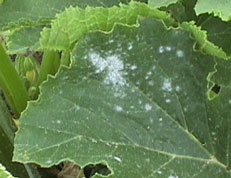Powdery mildew
Causal organism: Fungus
Important species
Powdery mildew of tomato, pepper, eggplant, potato and other solanacoeus crops, squash, cucumber and other cucurbits (Erysiphe orontii)
Powdery mildew of carrot (E. polygoni)
Powdery mildew of cucurbits (E. cichoracearum; Sphaerotheca fuliginea, Podosphaera fusca; P. fuliginea)
Host plants
Cereals, grasses, vegetables, ornamentals, weeds, shrubs, fruit trees, and forest trees
Affected plant stages
Seeding, vegetative, and reproductive stages
Affected plant parts
Leaves, petioles, stems, and sometimes, fruits
Symptoms
 Photo courtesy of Andy Wyenandt
Photo courtesy of Andy Wyenandt
The Ohio State University
Powdery mildew is characterized by a dusty-white to gray coating and talcum powder-like growth commonly infecting plant's leaves. It begins as circular, powdery-white spots that turn yellow-brown and finally black. In most cases, the fungal growth can be partially removed by rubbing the leaves.
Powdery mildew is commonly found on the upper side of the leaf. It also infects the underneath surface of the leaf, young stem, bud, flower, and young fruit. The infected leaf becomes distorted, turns yellow with small patches of green, and falls off prematurely. Infected buds fail to open. Other injuries include stunting and distortion of leaves, buds, growing tips, and fruits. Infected seedlings will eventually die.
Conditions that favor development
n- Warm and dry climate with high humidity
- Infected seeds and planting materials
- Overcrowded plants
Prevention and control
- Plant resistant cultivars when available
- Practice a wider spacing between the hills and the rows to increase air flow among plants, and light penetration
- Practice crop rotation
- Remove infected plant materials and alternative hosts
- Prune overcrowded plants to increase air circulation, reduce the relative humidity, reduce infection, and increase the light penetration
- Plow under all plant residues or remove plant residues after harvest. Do not place infected plant materials on the compost pile
- Ginger powder extract
- Neem seed extract
- Papaya extract
- Turmeric extract
- Baking soda
- Bordeaux mix
- Seed treatment
- Compost tea

